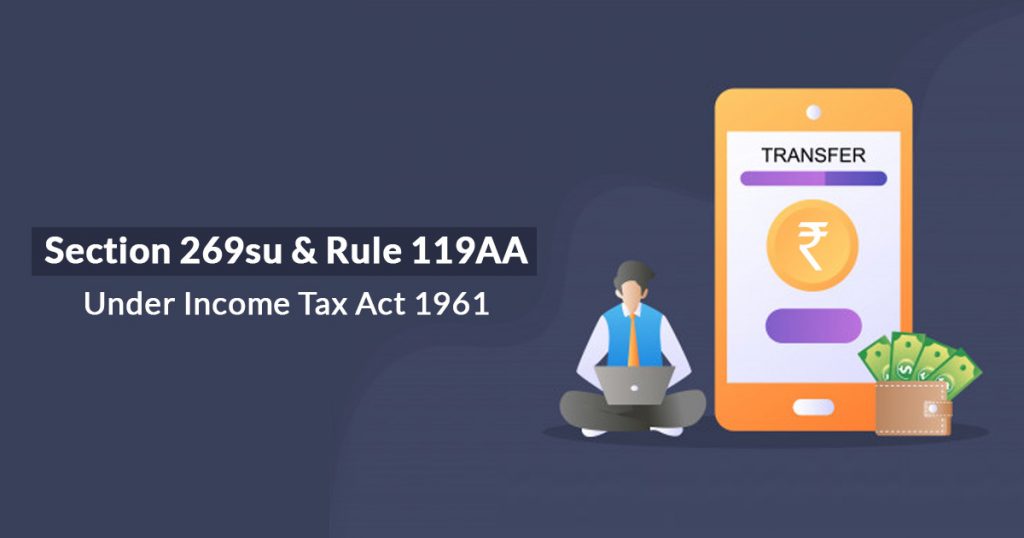
As an initiative to boost digital payments and bolster the cashless economy, the Government of India has introduced a new provision Section 269SU Prescribed Electronic Mode and subsequently notified Rule 119AA through the Finance (No. 2) Act, 2019 that prescribes certain electronic modes of payments as a mandatory facility for costumers to be given by businessmen.
These electronic modes of payment are mandatory for all the business establishments and entities whose total sales, turnover or gross receipts from business surpass the limit of INR 50 crore during the immediately preceding previous year.
Let us have a look at these sections and provisions that evidence the government’s move towards digitisation as far as payments are concerned.
Imposition of Electronic Modes Under Section 269SU
MoF and CBDT released Circular Number 16/2020 and mentioned 3 important acts they took to promote digital transactions and move toward a less-cash economy, the first one was the insertion of 269SU in the Income-tax Act, 1961 which made it mandatory for every person having a business turnover of more than Rs. 50 crores during the immediately preceding previous year will have to provide facilities for accepting payments through prescribed electronic modes.
The next one was the insertion of 10A in the Payment and Settlement Systems Act 2007 which states that no bank or system can’t impose a charge on the receiver or sender. It also mentioned Circular no. 32/2019 which states that if any bank collected charges after 1st January 2020 they have to immediately refund the collected amount.
Section 269SU Under the Income Tax Act 1961
Section 269SU prescribes the electronic modes for payment acceptance that an individual who is engaged in business has to provide in addition to the other electronic facility or digital mode of payment already available for the customers.
Section 269SU under the Income Tax Act is operative for the traders or businessmen whose total sales, turnover or gross receipts from the business are more than INR 50 crore in the just preceding previous year.
The section became effective on 1 November 2019, this indicates the relevance of the section in cases when the sales, turnover or gross receipts are more than INR 50 crore for the fiscal year ended on 31 March 2019.
Rule 119AA of the Income Tax Act 1961
The prescribed electronic modes of payment in consonance with section 269SU were notified by the Central Board of Direct Taxes (CBDT). These modes are as follows:
- Debit Card powered by RuPay
- Unified Payments Interface (UPI) (BHIM-UPI)
- Unified Payments Interface Quick Response Code (UPI QR Code) (BHIM-UPI QR Code)
The Rule 119AA of the Income-tax Act became effective on 1 January 2020 and so now every individual who comes under the purview of Section 269SU or to whom this section is applicable has to make the above-mentioned modes of payment available for its customers.
Provision of Penalty till 31st Jan 2020
The penalty under section 271DB of the Act will not be applicable to the concerned person to install electronic modes of payment at his business venture until 31st Jan 2020 giving him enough time to install the same.
Also, it is to be noticed that the concerned person will be liable to pay INR 5,000 per day from 1st Feb 2020 onwards in case he fails to do the required installation of electronic mode payment under section 271DB of the Act
Section 269SU & Purpose Under Income Tax
Section 269SU was introduced by the government to push digital payments and a cashless economy. The government is motivating low-cost digital modes of payment like BHIM UPI, Aadhaar Pay, UPI-QR Code, NEFT, certain debit cards, RTGS etc so that a cashless economy can be promoted.
Section 269SU applies to business establishments having an annual turnover of more than INR 50 crores i.e. such businesses with an annual turnover of more than INR 50 crores must facilitate their customers with prescribed low-cost digital modes of payment.
Besides, the government has made it mandatory for the bank or the payment system provider not to impose any charges or merchant discount rates on the customers and the merchants as well for using the methods of payments stated u/s 269SU.
The costs paid towards these modes of payment have to be borne by the banks or the Reserve Bank of India.
Amendment to the Payment and Settlement Systems Act, 2007
A new section 10A was added to the Payment and Settlement Systems Act, 2007, which became effective from 1 November 2019.
According to this new section, a bank or payment system provider shall not levy any charges on anyone, directly or indirectly, for making use of the digital modes of payment stated u/s 269SU of the Income Tax Act, 1961
The Finance (No. 2) Act, 2019 introduced the section.
Hence, no charges would be imposed by any bank or payment system provider on the individual who is making the payment or receiving the payment via any of the prescribed modes u/s 269SU.
Section 269SU Penalty for Non-compliance Under Income Tax
When an individual, to whom the provisions of section 269SU are applicable or who comes in the ambit of the provisions of section 269SU, fails to comply with the prescriptions of the section i.e. he does not provide the facility of payment through the prescribed modes of payment, then the section 269su penalty of INR 5,000 per day in the entire period of non-availability of the facility, will be imposed on him by the Joint Commissioner of Income Tax.
A show-cause notice is ordinarily issued to such defaulters as a chance to prove why they should not be penalised for non-adherence. When the reasons given by the defaulter for the non-compliance are considered valid and adequate by the Joint Commissioner then the penalty may not be imposed on the defaulter.